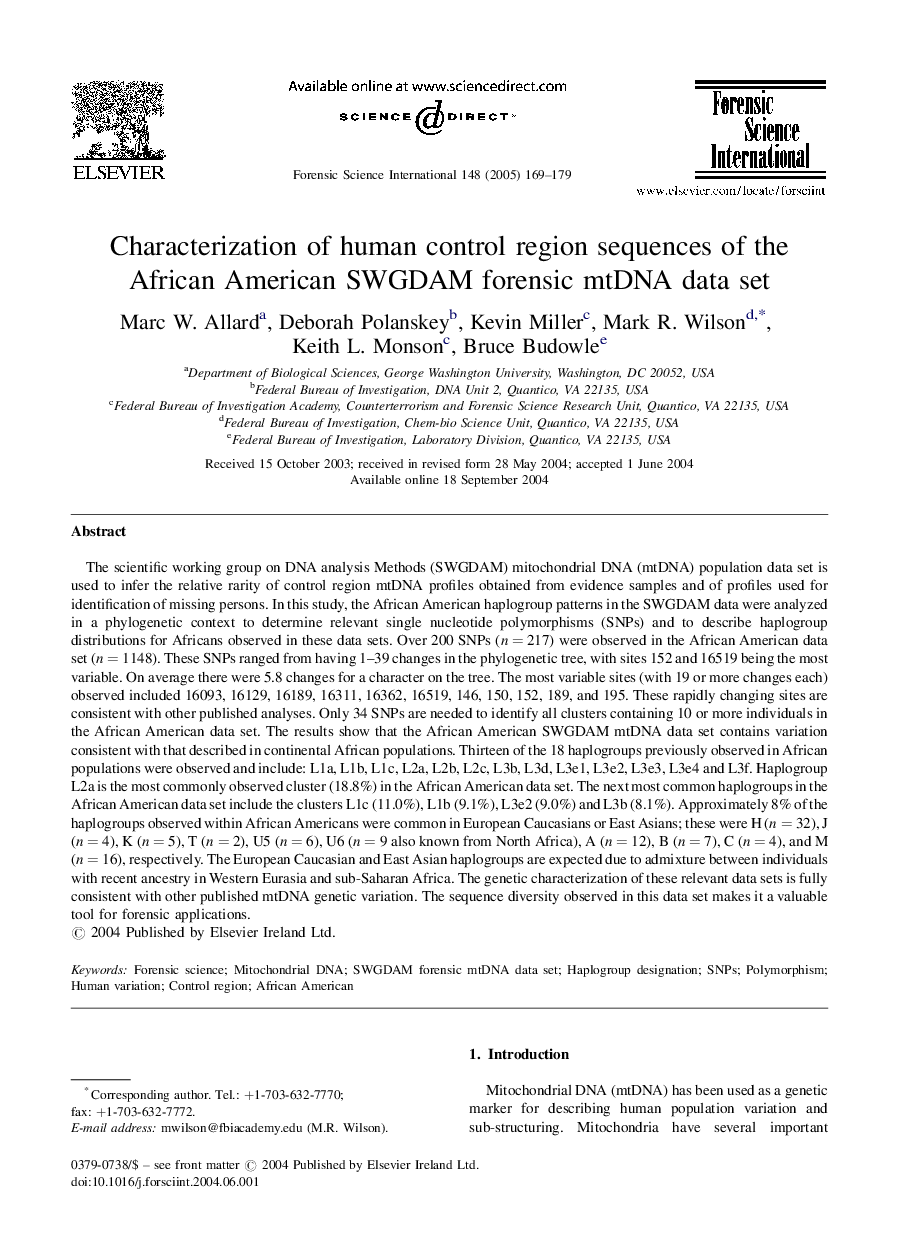| کد مقاله | کد نشریه | سال انتشار | مقاله انگلیسی | نسخه تمام متن |
|---|---|---|---|---|
| 9622616 | 160547 | 2005 | 11 صفحه PDF | دانلود رایگان |
عنوان انگلیسی مقاله ISI
Characterization of human control region sequences of the African American SWGDAM forensic mtDNA data set
دانلود مقاله + سفارش ترجمه
دانلود مقاله ISI انگلیسی
رایگان برای ایرانیان
کلمات کلیدی
موضوعات مرتبط
مهندسی و علوم پایه
شیمی
شیمی آنالیزی یا شیمی تجزیه
پیش نمایش صفحه اول مقاله

چکیده انگلیسی
The scientific working group on DNA analysis Methods (SWGDAM) mitochondrial DNA (mtDNA) population data set is used to infer the relative rarity of control region mtDNA profiles obtained from evidence samples and of profiles used for identification of missing persons. In this study, the African American haplogroup patterns in the SWGDAM data were analyzed in a phylogenetic context to determine relevant single nucleotide polymorphisms (SNPs) and to describe haplogroup distributions for Africans observed in these data sets. Over 200 SNPs (n = 217) were observed in the African American data set (n = 1148). These SNPs ranged from having 1-39 changes in the phylogenetic tree, with sites 152 and 16519 being the most variable. On average there were 5.8 changes for a character on the tree. The most variable sites (with 19 or more changes each) observed included 16093, 16129, 16189, 16311, 16362, 16519, 146, 150, 152, 189, and 195. These rapidly changing sites are consistent with other published analyses. Only 34 SNPs are needed to identify all clusters containing 10 or more individuals in the African American data set. The results show that the African American SWGDAM mtDNA data set contains variation consistent with that described in continental African populations. Thirteen of the 18 haplogroups previously observed in African populations were observed and include: L1a, L1b, L1c, L2a, L2b, L2c, L3b, L3d, L3e1, L3e2, L3e3, L3e4 and L3f. Haplogroup L2a is the most commonly observed cluster (18.8%) in the African American data set. The next most common haplogroups in the African American data set include the clusters L1c (11.0%), L1b (9.1%), L3e2 (9.0%) and L3b (8.1%). Approximately 8% of the haplogroups observed within African Americans were common in European Caucasians or East Asians; these were H (n = 32), J (n = 4), K (n = 5), T (n = 2), U5 (n = 6), U6 (n = 9 also known from North Africa), A (n = 12), B (n = 7), C (n = 4), and M (n = 16), respectively. The European Caucasian and East Asian haplogroups are expected due to admixture between individuals with recent ancestry in Western Eurasia and sub-Saharan Africa. The genetic characterization of these relevant data sets is fully consistent with other published mtDNA genetic variation. The sequence diversity observed in this data set makes it a valuable tool for forensic applications.
ناشر
Database: Elsevier - ScienceDirect (ساینس دایرکت)
Journal: Forensic Science International - Volume 148, Issues 2â3, 10 March 2005, Pages 169-179
Journal: Forensic Science International - Volume 148, Issues 2â3, 10 March 2005, Pages 169-179
نویسندگان
Marc W. Allard, Deborah Polanskey, Kevin Miller, Mark R. Wilson, Keith L. Monson, Bruce Budowle,